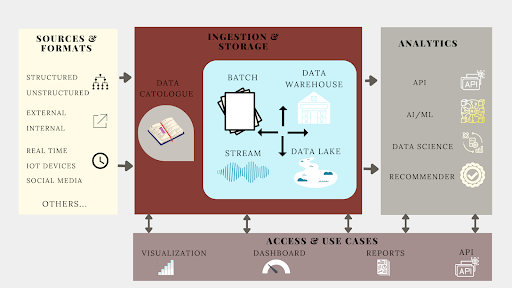Data architecture maps the structure of an organization’s data and how the data flows to serve business objectives. Designing effective data architecture requires knowledge of both data needs and business processes.
What Is Data Architecture?
Data architecture is a framework of systems, models and standards that guide how an organization collects, processes, stores and accesses data.
Components of Data Architecture
A well-structured data architecture is built on several core components that work together to manage the flow, storage and accessibility of data across an organization. Here’s a breakdown of the most essential elements:
1. Data Sources
These are the origins of data — from internal systems like customer relationship management (CRM) platforms and enterprise resource planning (ERP) software to external inputs like APIs, IoT devices and third-party data providers. Data sources feed the entire data architecture and must be mapped and classified for governance and integration.
2. Data Ingestion and Integration
Once identified, data needs to be brought into the system. This includes batch ingestion pipelines, real-time streaming (like Kafka or Flink) and ETL (extract, transform, load) or ELT (extract, load, transform) processes. Effective integration ensures that data from multiple sources is harmonized and usable downstream.
3. Data Storage
Data storage solutions vary by use case, but typically include data lakes for unstructured data and data warehouses for structured, query-optimized storage. Technologies like Snowflake, Amazon S3 or Google BigQuery are common. Modern data architecture often embraces a data lakehouse approach that blends both data lake and data warehouse approaches.
4. Data Processing
Data processing transforms raw data into insights. This includes tools for data cleaning, normalization and enrichment. Processing can happen in real-time (streaming analytics) or in scheduled batches, depending on latency and performance needs.
5. Data Modeling
Data modeling defines how data is structured and related across the system — from high-level conceptual models to physical database schemas. It supports data consistency, simplifies access and lays the foundation for scalable analytics.
6. Metadata Management
Metadata — data about data — provides context like source, owner, lineage and access policies. A strong metadata layer enhances discoverability, enables governance and supports observability across the data lifecycle.
7. Data Governance and Security
Data governance and security includes policies, roles and tools that manage data quality, compliance (like GDPR or HIPAA), access control and risk mitigation. Effective governance ensures that data remains a trusted and strategic asset.
8. Data Access and Consumption
Data must be accessible to users, whether through business intelligence tools like Tableau, dashboards, APIs or embedded analytics. The data architecture should support self-service access while maintaining performance and security at scale.
How Does Data Architecture Work?
In the past, simple data architecture has served organizations well. It used to be easy to map out a simple data architecture with a single database using extract, transform and load (ETL) processes.
As an example, a simple data architecture could look like the following:

Here, the architecture should map out the sources of the data and formats (e.g., internal vs. external sources, structured vs. unstructured data). The next layer deals with data ingestion and storage. The data catalog binds together the organization’s data; the catalog matches the data source’s needs to the type of storage and processing the data requires.
For example, a data lake stores low-performant unstructured data while a data warehouse holds data in a structured format that can serve consumers. The analytics layer can help with data processing with data science tools (see figure above). Finally, users should be able to access what they need, like data visualization and reports.
With this in mind, data architectures are becoming more complex. Advances in cloud computing, machine learning and data proliferation present new challenges. For example, real-time data analytics and pipelines increase the complexity of data architectures. Companies now deal with such high-speed data that architectures must be able to handle spikes of data volumes when required.
It’s important to remember that organizations must update data architectures as data and business needs shift. New technological breakthroughs might also demand revisions to data architecture.
Types of Data Architecture Frameworks
Data architecture frameworks lay out the principles and standards used to develop the data architecture roadmap for an organization. Here are some of the most common frameworks used:
The Open Group Architecture Framework (TOGAF)
The Open Group Architecture Framework (TOGAF). The TOGAF framework has a specific architecture development method (ADM) section, which describes how to develop and manage enterprise architecture. TOGAF also highlights architectural best practices.
DAMA-DMBOK 2
The Data Management Body of Knowledge (DAMA-DMBOK 2) defines 11 key areas of data management — including governance, modeling, architecture and quality. It treats data as a strategic asset and promotes clear roles, standards and policies across the data lifecycle. DAMA-DMBOK 2 is a go-to reference for building scalable, compliant data practices, especially in regulated industries.
Zachman Framework for Enterprise Architecture
The Zachman Framework offers a matrix-based view of enterprise architecture. It answers six core questions (what, how, where, who, when, why) from multiple stakeholder perspectives. The “what” column focuses on data — helping organizations map out models, definitions and dependencies. The Zachman Framework tool helps align data architecture with broader business and IT strategy, especially in large, complex organizations.
Types and Examples of Data Architectures
Data architecture comes in different forms and changes based on business needs, data volume and the technologies in play. Below are several common data architecture patterns used across industries — each optimized for different priorities like speed, flexibility or scalability.
1. Centralized Data Architecture
In a centralized model, all data flows into a single, unified system — often a data warehouse. This architecture simplifies data governance and access control, making it a fit for organizations that prioritize consistency and regulatory compliance. It’s popular in sectors like finance and healthcare, where data integrity is critical.
Example: A hospital system routes patient records, lab results and insurance data into a centralized warehouse to enable secure, unified reporting across departments.
2. Decentralized (or Federated) Data Architecture
Here, each department or business unit maintains its own data infrastructure while adhering to shared standards. Decentralized architectures offer agility and local control but require strong governance to avoid data silos.
Example: A multinational retailer allows each regional office to manage its customer data locally, while corporate defines global metadata and privacy policies.
3. Distributed Data Architecture
Distributed architectures spread data across multiple systems or locations, often globally, to improve availability, fault tolerance and performance. These systems are designed to replicate and synchronize data across regions or clouds — making them ideal for businesses with global footprints.
Example: A global e-commerce platform distributes customer and inventory data across data centers in North America, Europe and Asia to reduce latency and ensure uptime during regional outages.
4. Data Lake Architecture
A data lake stores raw, unstructured and semi-structured data at scale. It’s a flexible foundation for machine learning, data exploration and advanced analytics — ideal for organizations handling diverse or large-scale data sets.
Example: A media company ingests video files, clickstream logs and social media data into an Amazon S3-based data lake to power content recommendations.
5. Event-Driven Architecture
Built around real-time data streaming, this architecture uses technologies like Apache Kafka or AWS Kinesis to move and process data in response to specific events. It supports use cases that demand low latency and real-time responsiveness.
Example: A ride-sharing app updates driver locations, ETAs and traffic alerts in real-time using an event-driven architecture to improve user experience.
6. Modern Data Stack
This cloud-native architecture can combine tools like Fivetran (for ingestion), dbt (for transformation), Snowflake or BigQuery (for storage) and Looker or Tableau (for visualization). It emphasizes modularity, scalability and rapid iteration and is often adopted by fast-moving tech companies.
Example: A SaaS startup uses a modern data stack to sync product usage data, perform real-time analytics and power customer success dashboards.
Benefits of Data Architecture
Organizations should have solid data architecture to support their business needs. Well-designed and updated data architectures enable organizations to:
- Better understand data needs and align those needs with business requirements.
- Develop sustainable and adaptable logical data structures to meet the organization’s future needs.
- Aid in data management and governance.
- Improve data quality and consistency.
- Serve as a foundation for the company’s data strategies.
- Help reduce data storage and processing costs by understanding the nature of data and its actual value.
Risks of Data Architecture
Though data architectures are critical for organizations to manage data, they can come with risks:
- Rapid technological advances and changes in business needs can undermine effective data architectures.
- When adding new lines and shapes to a data architecture’s data flow, it becomes very difficult to keep them updated and consistent. This can lead to duplicate data processes, high costs and increased maintenance time for business.
- Organizations often have to balance the complexity of data architectures, business needs and new tools/platforms for data management in order to properly meet business vision and goals.
Data Architecture vs. Data Modeling
Though closely related, data architecture and data modeling serve distinct purposes within the broader data ecosystem — one defines the blueprint, the other handles the details.
Data Architecture
Data architecture is the high-level framework that outlines how data is collected, stored, integrated, and used across an organization. It sets the strategic vision — defining data flows, system relationships, governance rules and platform choices. Think of it as the city planning of data infrastructure.
Data Modeling
Data modeling dives into the specifics — creating visual representations of how data entities relate to each other within a system. It includes conceptual, logical and physical models that shape how databases are designed, queried and maintained.
How Data Architecture and Data Modeling Work Together
Data modeling lives within the structure provided by data architecture. While architecture sets the foundation and direction, modeling ensures data is structured and aligned to meet that strategy. Together, they enable scalable, efficient and compliant data systems.
Frequently Asked Questions
What are the types of data architecture?
Common types of data architecture include:
- Centralized data architecture
- Decentralized (or federated) data architecture
- Distributed data architecture
- Data lake architecture
- Event-driven data architecture
- Modern data stack architecture
What are the main components of data architecture?
Main components of data architecture include:
- Data sources
- Ingestion and integration pipelines
- Data storage solutions (like data warehouses or lakes)
- Data processing
- Data modeling
- Metadata management
- Data governance and security
- Data access tools
Is ETL part of data architecture?
Yes, ETL (Extract, Transform, Load) or ELT (Extract, Load, Transform) is a critical part of the data ingestion and integration layer within a data architecture. These processes move and prepare data from diverse sources for storage and analysis, ensuring consistency and usability across systems.
What does a data architect do?
A data architect designs the blueprint for how an organization manages, stores and accesses data. They help define systems, structures and standards that ensure data flows efficiently and securely, aligning with both technical requirements and business goals.





